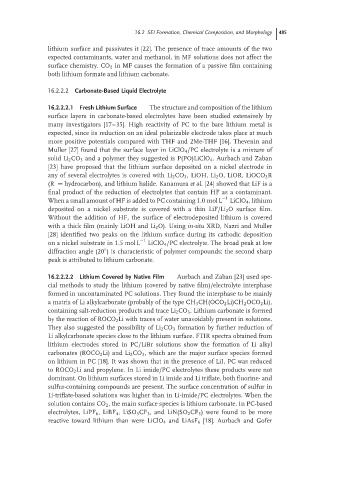Page 512 - Handbook of Battery Materials
P. 512
16.2 SEI Formation, Chemical Composition, and Morphology 485
lithium surface and passivates it [22]. The presence of trace amounts of the two
expected contaminants, water and methanol, in MF solutions does not affect the
surface chemistry. CO 2 in MF causes the formation of a passive film containing
both lithium formate and lithium carbonate.
16.2.2.2 Carbonate-Based Liquid Electrolyte
16.2.2.2.1 Fresh Lithium Surface The structure and composition of the lithium
surface layers in carbonate-based electrolytes have been studied extensively by
many investigators [17–35]. High reactivity of PC to the bare lithium metal is
expected, since its reduction on an ideal polarizable electrode takes place at much
more positive potentials compared with THF and 2Me-THF [16]. Thevenin and
Muller [27] found that the surface layer in LiClO 4 /PC electrolyte is a mixture of
solid Li 2 CO 3 and a polymer they suggested is P(PO)LiClO 4 . Aurbach and Zaban
[23] have proposed that the lithium surface deposited on a nickel electrode in
any of several electrolytes is covered with Li 2 CO 3 ,LiOH, Li 2 O, LiOR, LiOCO 2 R
(R = hydrocarbon), and lithium halide. Kanamura et al. [24] showed that LiF is a
final product of the reduction of electrolytes that contain HF as a contaminant.
When a small amount of HF is added to PC containing 1.0mol L −1 LiClO 4 , lithium
deposited on a nickel substrate is covered with a thin LiF/Li 2 O surface film.
Without the addition of HF, the surface of electrodeposited lithium is covered
with a thick film (mainly LiOH and Li 2 O). Using in-situ XRD, Nazri and Muller
[28] identified two peaks on the lithium surface during its cathodic deposition
on a nickel substrate in 1.5 mol L −1 LiClO 4 /PC electrolyte. The broad peak at low
◦
diffraction angle (20 ) is characteristic of polymer compounds; the second sharp
peak is attributed to lithium carbonate.
16.2.2.2.2 Lithium Covered by Native Film Aurbach and Zaban [23] used spe-
cial methods to study the lithium (covered by native film)/electrolyte interphase
formed in uncontaminated PC solutions. They found the interphase to be mainly
a matrix of Li alkylcarbonate (probably of the type CH 3 CH(OCO 2 Li)CH 2 OCO 2 Li),
containing salt-reduction products and trace Li 2 CO 3 . Lithium carbonate is formed
by the reaction of ROCO 2 Li with traces of water unavoidably present in solutions.
They also suggested the possibility of Li 2 CO 3 formation by further reduction of
Li alkylcarbonate species close to the lithium surface. FTIR spectra obtained from
lithium electrodes stored in PC/LiBr solutions show the formation of Li alkyl
carbonates (ROCO 2 Li) and Li 2 CO 3 , which are the major surface species formed
on lithium in PC [18]. It was shown that in the presence of LiI, PC was reduced
to ROCO 2 Li and propylene. In Li imide/PC electrolytes these products were not
dominant. On lithium surfaces stored in Li imide and Li triflate, both fluorine- and
sulfur-containing compounds are present. The surface concentration of sulfur in
Li-triflate-based solutions was higher than in Li-imide/PC electrolytes. When the
solution contains CO 2 , the main surface species is lithium carbonate. In PC-based
electrolytes, LiPF 6 ,LiBF 4 , LiSO 3 CF 3 , and LiN(SO 2 CF 3 ) were found to be more
reactive toward lithium than were LiClO 4 and LiAsF 6 [18]. Aurbach and Gofer

